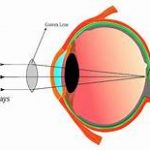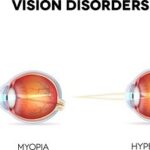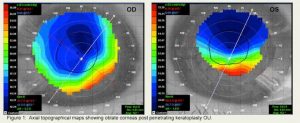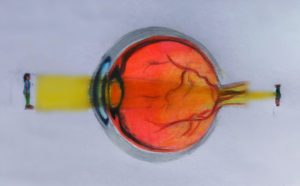Regular and Irregular astigmatism
Introduction:
Astigmatism is a common vision problem caused by an error in the shape of the cornea. With astigmatism, the lens of the eye or the cornea, which is the front surface of the eye, has an irregular curve. This can change the way light passes, or refracts, to your retina, causing blurry, fuzzy, or distorted vision. Symptoms can differ from person to person but may include blurry vision and difficulty seeing at night. Due to this condition, the light rays that enter the eye fail to converge at a single focal point on the retina and form two foci instead. The lack of a single focus point results in the formation of blurred images on the retina. Clinically, astigmatism is commonly seen in combination with other refractive errors such as myopia, hyperopia, or sometimes as mixed.
Etiology:
Although the cause is not known, but genetics is a big factor. It’s often present at birth, but it may develop later in life. It may also occur as a result of an injury to the eye or after eye surgery. Astigmatism often occurs with nearsightedness or farsightedness. Sometimes, though, a rare condition called keratoconus causes astigmatism. This eye disease affects the cornea, causing the clear tissue on the cornea to thin and bulge out. This leads to cloudy or blurry vision, and sensitivity to bright lights. The cause of keratoconus is also unknown, but it’s believed to be hereditary, too.
Risk factors:
The following are the risk factors:
A family history of astigmatism or other eye disorders, such as keratoconus (degeneration of the cornea)
Scarring or thinning of your cornea
Excessive nearsightedness, which creates blurry vision at a distance
Excessive farsightedness, which creates blurry close- up vision
A history of certain types of eye surgery, such as cataract surgery (surgical removal of a clouded lens).
Symptoms:
The symptoms of astigmatism may differ in each person. Some people don’t have any symptoms at all. The primary symptoms of astigmatism include:
Blurry, distorted, or fuzzy vision at all distances (up close and far away)
Difficulty seeing at night
Eyestrain
Squinting
Eye irritation
Headaches
Types:
Astigmatism are of two kinds, regular and irregular astigmatism. In regular astigmatism, the two principle meridians are separated by 90 degree. This is the most common form of astigmatism. Regular astigmatism is not an ocular health problem, but rather it is an issue with the structure of the eye and how it’s shaped. In irregular astigmatism, there are more than two principle meridians which are not separated by 90 degree. This is
less common form of astigmatism.
Regular astigmatism can be further classified into 3 types:
With the rule: In this type, the two principle meridians are right angle to each other but vertical meridian is more curved than horizontal meridian.
Against the rule: In this type, the two principle meridians are right angle to each other but horizontal meridian is more curved than vertical meridian.
Oblique: In this kind of astigmatism, the axis are right angle to each other but are doesn’t lie in neither of horizontal meridian nor vertical meridian but are crossed obliquely.
Irregular astigmatism is of only one type:
Bi-Oblique: In this type, the two principle meridians are not right angle to each other i.e. one may be 40° and other may be 100°. A small amount of irregular astigmatism is seen in every eye when the entire cornea is assessed; however, this is medically irrelevant. Irregular astigmatism, which is
clinically relevant, is very uncommon compared with the regular form. It is seen in patients with an irregular corneal surface that occurs either due to natural causes or are causes that are surgically induced.
Different corneal pathologies related to elevated lesions, like Salzmann’s nodular degeneration or keratoconus, are the natural causes of irregular astigmatism. These causes lead to primary irregular astigmatism and secondary irregular astigmatism.
Simple and Compound astigmatism:
Simple astigmatism:
Simple myopic astigmatism: One of the two principal meridians of the eye focuses light rays in front of the retina. The other focuses correctly onto the retina.
Simple hypermetropic astigmatism: One of the two principal meridians focuses rays of light behind the retina. The other focuses correctly onto the retina.
Compound astigmatism:
Compound myopic astigmatism: The two main meridians of the eye focus light rays in front of the retina.
Compound hypermetropic astigmatism: The two principle meridians focus light rays behind the retina.
Mixed astigmatism: One principle meridian focuses the light in front of the retina and the other behind.
Treatment:
There are several ways to correct astigmatism, including:
Eyeglasses – Astigmatism correction prescribed in glasses can help to focus light rays correctly, improving vision.
Contact lenses, including toric contact lenses, can also be used to correct astigmatism.
Refractive surgery, such as LASIK or a photorefractive keratectomy (PRK), can reshape the cornea to correct astigmatism. Diseases that cause irregular astigmatism may require corneal transplants or collagen cross-linking to improve or stabilize vision.










